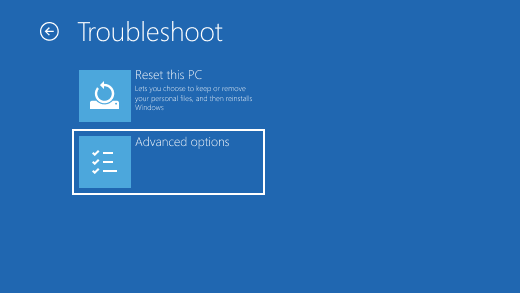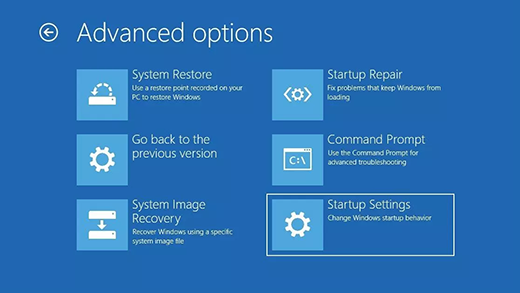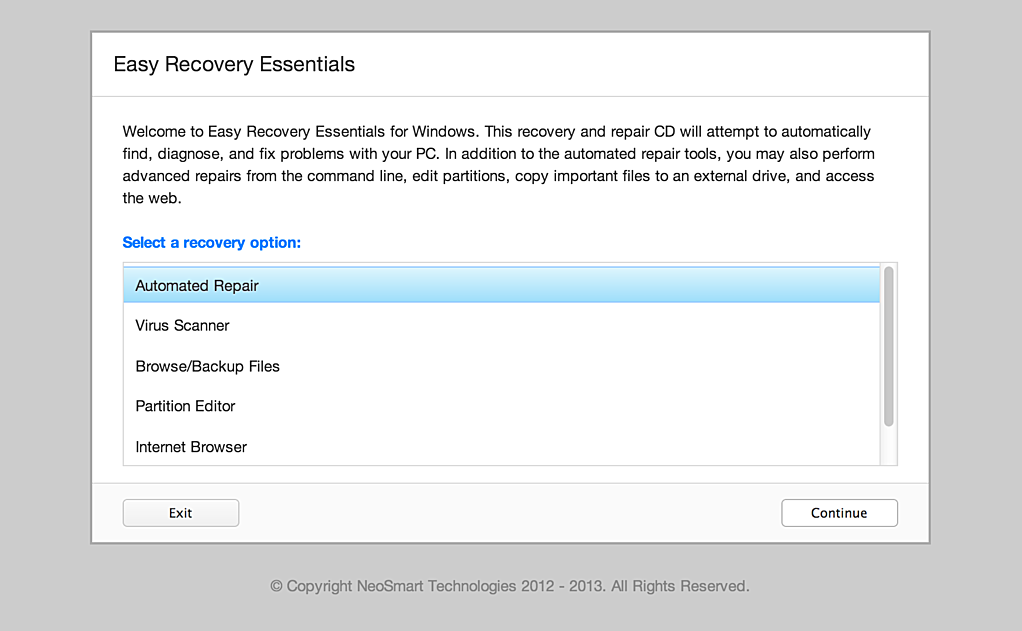- Start your PC in safe mode in Windows 10
- Advanced startup options (including safe mode)
- Repair Your Computer
- Safe Mode
- Windows Startup in Infinite Reboot Loop: Fix for Windows XP, Vista, 7, 8, 8.1
- About the “Windows Infinite Reboot Loop”
- Description and Symptoms
- Symptom 1: Every attempt to start Windows just results in a reboot
- Causes of this Error
- Cause 1: Blue Screen of Death during startup
- Fixing an “endless reboot loop” on Windows
- Fix #1: Use System Restore via Easy Recovery Essentials
- Fix #2: Disable automatic restart on system failure
- Fix #3: Use Startup Repair
- More Information
- Linked Entries
- Support Links
- Applicable Systems
Start your PC in safe mode in Windows 10
Safe mode starts Windows in a basic state, using a limited set of files and drivers. If a problem doesn’t happen in safe mode, this means that default settings and basic device drivers aren’t causing the issue. Observing Windows in safe mode enables you to narrow down the source of a problem, and can help you troubleshoot problems on your PC.
There are two versions of safe mode: Safe Mode and Safe Mode with Networking. Safe Mode with Networking adds the network drivers and services you’ll need to access the Internet and other computers on your network.
Select from the following sections to find out how to start your PC in safe mode from Settings, from the sign-in screen, or from a black or blank screen.
Press Windows logo key + I on your keyboard to open Settings. If that doesn’t work, select the Start button, then select Settings .
Under Advanced startup, select Restart now.
After your PC restarts to the Choose an option screen, select Troubleshoot > Advanced options > Startup Settings > Restart. You may be asked to enter your BitLocker recovery key.
After your PC restarts, you’ll see a list of options. Select 4 or press F4 to start your PC in Safe Mode. Or if you’ll need to use the Internet, select 5 or press F5 for Safe Mode with Networking.
When you can’t open Settings to get into safe mode, restart your device from the Windows sign-in screen.
On the Windows sign-in screen, press and hold the Shift key while you select the Power > Restart .
After your PC restarts to the Choose an option screen, select Troubleshoot > Advanced options > Startup Settings > Restart. You may be asked to enter your BitLocker recovery key.
After your PC restarts, you’ll see a list of options. Select 4 or F4 to start your PC in safe mode. Or if you’ll need to use the Internet, select 5 or F5 for Safe Mode with Networking.
Note: If you’ve encrypted your device, you’ll need your BitLocker key to start in safe mode.
Before you enter safe mode, you need to enter the Windows Recovery Environment (winRE). To do this, you will repeatedly turn your device off, then on:
Hold down the power button for 10 seconds to turn off your device.
Press the power button again to turn on your device.
On the first sign that Windows has started (for example, some devices show the manufacturer’s logo when restarting) hold down the power button for 10 seconds to turn off your device.
Press the power button again to turn on your device.
When Windows restarts, hold down the power button for 10 seconds to turn off your device.
Press the power button again to turn on your device.
Allow your device to fully restart. You will enter winRE.
Now that you are in winRE, you will follow these steps to take you to safe mode:
On the Choose an option screen, select Troubleshoot > Advanced options > Startup Settings > Restart.
After your device restarts, you’ll see a list of options. Select option 5 from the list or press F5 for Safe Mode with Networking.
If you need more info on a black or blank screen error, see Troubleshoot black or blank screen errors.
Notes: If you need to exit safe mode, simply restart your device, or:
Press the Windows logo key + R.
Type msconfig in the Open box and then select OK.
Select the Boot tab.
Under Boot options, clear the Safe boot checkbox.
Advanced startup options (including safe mode)
The Advanced Boot Options screen lets you start Windows in advanced troubleshooting modes. You can access the menu by turning on your computer and pressing the F8 key before Windows starts.
Some options, such as safe mode, start Windows in a limited state, where only the bare essentials are started. If a problem doesn’t reappear when you start in safe mode, you can eliminate the default settings and basic device drivers and services as possible causes. Other options start Windows with advanced features intended for use by system administrators and IT professionals. For more information, go to the Microsoft website for IT professionals.
Repair Your Computer
Shows a list of system recovery tools you can use to repair startup problems, run diagnostics, or restore your system. This option is available only if the tools are installed on your computer’s hard disk. If you have a Windows installation disc, the system recovery tools are located on that disc.
Safe Mode
Starts Windows with a minimal set of drivers and services.
To start in safe mode:
Remove all floppy disks, CDs, and DVDs from your computer, and then restart your computer. Click the Start button , click the arrow next to the Shut Down button (or the arrow next to the Lock button), and then click Restart.
Do one of the following:
If your computer has a single operating system installed, press and hold the F8 key as your computer restarts. You need to press F8 before the Windows logo appears. If the Windows logo appears, you’ll need to try again by waiting until the Windows logon prompt appears, and then shutting down and restarting your computer.
If your computer has more than one operating system, use the arrow keys to highlight the operating system you want to start in safe mode, and then press F8.
On the Advanced Boot Options screen, use the arrow keys to highlight the safe mode option you want, and then press Enter.
Log on to your computer with a user account that has administrator rights.
Safe Mode with Networking. Starts Windows in safe mode and includes the network drivers and services needed to access the Internet or other computers on your network.
Safe Mode with Command Prompt. Starts Windows in safe mode with a command prompt window instead of the usual Windows interface. This option is intended for IT professionals and administrators.
Enable Boot Logging. Creates a file, ntbtlog.txt, that lists all the drivers that are installed during startup and that might be useful for advanced troubleshooting.
Enable low-resolution video (640×480). Starts Windows using your current video driver and using low resolution and refresh rate settings. You can use this mode to reset your display settings. For more information, see Change your screen resolution.
Last Known Good Configuration (advanced). Starts Windows with the last registry and driver configuration that worked successfully.
Directory Services Restore Mode. Starts Windows domain controller running Active Directory so that the directory service can be restored. This option is intended for IT professionals and administrators.
Debugging Mode. Starts Windows in an advanced troubleshooting mode intended for IT professionals and system administrators.
Disable automatic restart on system failure. Prevents Windows from automatically restarting if an error causes Windows to fail. Choose this option only if Windows is stuck in a loop where Windows fails, attempts to restart, and fails again repeatedly.
Disable Driver Signature Enforcement. Allows drivers containing improper signatures to be installed.
Start Windows Normally. Starts Windows in its normal mode.
Windows Startup in Infinite Reboot Loop: Fix for Windows XP, Vista, 7, 8, 8.1
This knowledgebase article explains what’s really happening when you experience an endless reboot loop when starting Windows, usually with your PC flashing between the BIOS POST screen showing your PC manufacturer’s logo (like Dell, HP, Toshiba, Acer, ASUS, Samsung, LG, Lenovo) and then showing the Windows is loading screen.
This guide is for the following Windows versions: Windows XP, Vista, 7, 8 or 8.1
About the “Windows Infinite Reboot Loop”
The following information on this error has been compiled by NeoSmart Technologies, based on the information gathered and reported by our global network of engineers, developers, and technicians or partner organizations.
Description and Symptoms
The error messages, alerts, warnings, and symptoms below are tied to this error.
Symptom 1: Every attempt to start Windows just results in a reboot
Every time an attempt is made to power up and start a Windows PC running Windows XP, Windows Vista, Windows 7, or Windows 8, the startup procedure begins normally but once Windows has begun to load or just as the Windows startup screen and bootloading process is about to complete, the PC suddenly restarts.
A glimpse or flash of a blue screen may be visible for a short period of time (from a split-second to several seconds) as the PC begins to reboot.
Subsequent restarts or power cycles of the PC result in the same behavior.
Causes of this Error
This error has been known to occur as a result of one or more of the following:
Cause 1: Blue Screen of Death during startup
If every time you power up your PC it ends up trying to start Windows then suddenly restarting your PC back to the BIOS screen, what’s really happening is that your computer is experiencing a BSOD (blue screen of death) during the startup process, then rebooting in hopes of it working better next time (try, try again). Unfortunately, that’s often not the case and it ends up in a permanent reboot cycle.
The problem is that because it reboots when the BSOD occurs, you don’t get a chance to actually see the blue screen to note the error codes and text to research.
This was not the original behavior of earlier versions of Windows, which would normally stop at the blue screen of death if it occurs, and allow the user to view the details of the BSOD stop code and error text to aid in troubleshooting and researching solutions for this error.
Fixing an “endless reboot loop” on Windows
Windows Setup CD/DVD Required!
Some of the solutions below require the use of the Microsoft Windows setup CD or DVD. If your PC did not come with a Windows installation disc or if you no longer have your Windows setup media, you can use Easy Recovery Essentials for Windows instead. EasyRE will automatically find and fix many problems, and can also be used to solve this problem with the directions below.
Fix #1: Use System Restore via Easy Recovery Essentials
Easy Recovery Essentials can fix many errors such as this automatically using the System Restore feature of the bootable EasyRE environment. EasyRE is currently available for Windows XP, Vista, 7 and 8 and can be downloaded and created on any PC.
The System Restore feature of EasyRE is “fully non-destructive” — it does not in any way touch, remove, or undo changes to your personal files and folders (such as the Desktop, Downloads, Music, Pictures, etc.)
- Download Easy Recovery Essentials. It’s important to download the copy that corresponds to your Windows version (XP, Vista, 7 or 8). If you’re unsure, this guide can help you identify what version of Windows you have installed.
- Burn the image. Follow these instructions on how to burn the bootable ISO image very carefully, as making a bootable CD can be tricky! Alternatively, these instructions explain how to create a bootable EasyRE recovery USB stick/drive.
- Boot up your PC from the Easy Recovery Essentials CD or USB you created.
- Once EasyRE is running, choose the “Automated Repair” option and click Continue .
Choose “Automated Repair” in Easy Recovery Essentials
Choose the drive associated with the Windows installation you’re trying to repair.
Pick a restore point for EasyRE to recover.
After selecting the restore point you which to revert your system to, click on Restore to begin.
EasyRE will begin the process of restoring your system configuration to the state it was in at the date that was selected. Only system files and registries will be affected, as the Easy Recovery Essentials’ System Restore feature is non-destructive and does not affect user data.
Choose the drive associated with the Windows installation you’re trying to repair.
Fix #2: Disable automatic restart on system failure
This option lets you get the exact and complete error message accompanying the Blue Screen of Death by disabling the Automatic Restart option of Windows. Note: this will not fix the boot error you are experiencing in and of itself, but should provide more information that may prove critical in solving the underlying problem.
The option to disable automatic restart on system failure is available from the Advanced Boot Options menu at startup. The instructions below will trigger this behavior, more detailed instructions on disabling automatic restart on system failure are also available in our knowledgebase.
- Restart your computer
- Wait for your BIOS to complete POST (the screen with your manufacturer logo and/or system information)
- Quickly begin tapping F8 repeatedly, until you see the list of boot options
- Choose “Disable automatic restart on system failure”
- Press Enter and wait for your PC to boot.
What is the message on that screen and what error code does the BSOD display? The information on this Blue Screen of Death is vital to troubleshooting the actual, underlying issue.
Fix #3: Use Startup Repair
The Startup Repair or “Recovery Your Computer” feature, available from Windows Vista onwards (including Windows 7 and Windows 8 or 8.1, as well as Server 2008 and Server 2012) can be used to both attempt to correct the problem as well as perform system diagnostics in an attempt to pin-down what the specific underlying cause of the reboot loop, in the presence of the split-second BSOD or otherwise.
Startup Repair is an automated diagnosis and repair tool that is available from the Windows setup disc and can be used to find and repair some common problems. More information about how Startup Repair operates and what it does can be found in our knowledgebase. The following steps will initiate Startup Repair from the Windows setup disc:
Unable to boot into the Windows setup CD?
See our guide on setting up a PC to boot from the CD or DVD for troubleshooting and more detailed instructions.
- Insert your Windows installation DVD into your PC’s CD-ROM drive,
- Fully power down your PC, and make sure it has fully shut off,
- Power up your PC,
- Press any key when you see “Press any key to boot from CD or DVD..”
- Click the link titled “Repair your computer” in the bottom-lefthand corner, after first selecting your language and keyboard options.
- Wait for Startup Repair to scan your PC for Windows installations, then select your install from the list it shows:
- Choose “Startup Repair” from the list of available recovery options to begin:
- Startup Repair will begin scanning your installation for known issues and will attempt a repair, if possible.
More Information
Linked Entries
Support Links
It’s an easy-to-use and automated diagnostics disk. It’s available for Windows 8, Windows 7 and Windows Vista. It’s also available for Windows XP and Windows Server.
Read more at Windows Recovery Disks.
Applicable Systems
This Windows-related knowledgebase article applies to the following operating systems:
- Windows XP (all editions)
- Windows Vista (all editions)
- Windows 7 (all editions)
- Windows 8 (all editions)
- Windows 8.1 (all editions)
- Windows Server 2003 (all editions)
- Windows Server 2008 (all editions)
- Windows Server 2012 (all editions)















